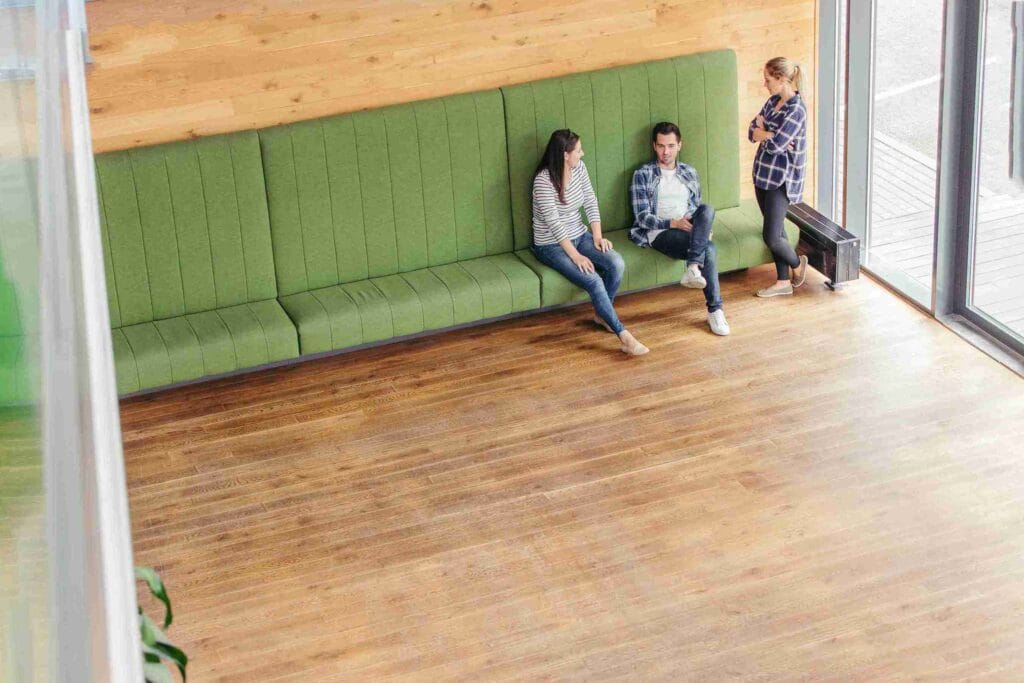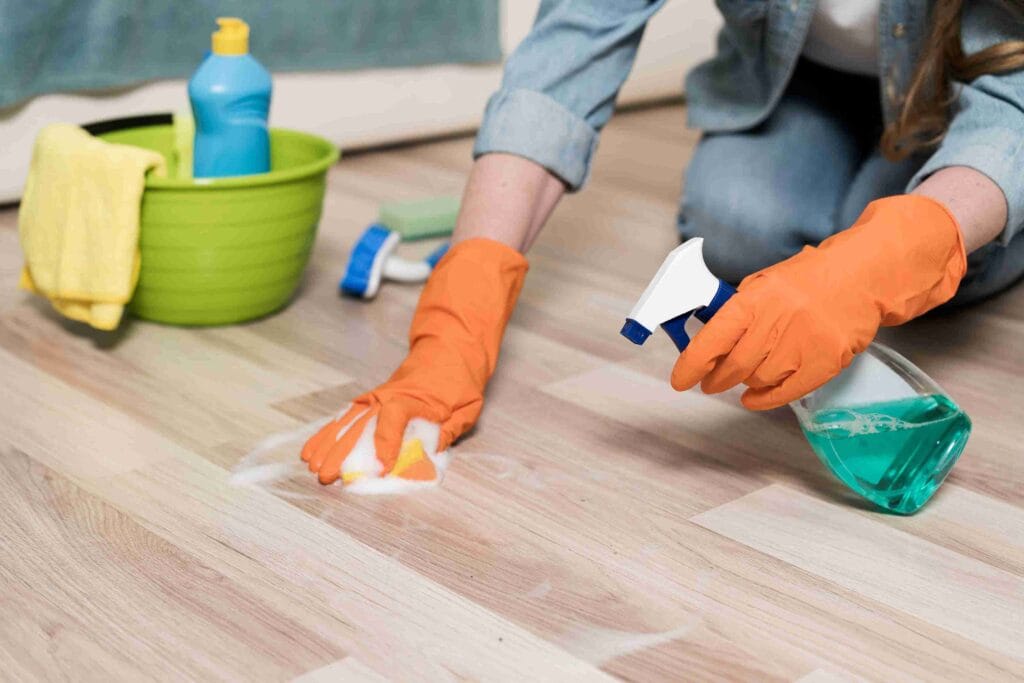- 10% Off Flooring Services
- Free Estimates

Dark furniture brings richness and depth to any room, but pairing it with the wrong wood flooring can throw off the entire design. The right floor color doesn’t just support the style—it enhances it, creating contrast, balance, and visual flow. From cool, modern tones to warm, inviting hues, today’s flooring trends offer a wide range of options to complement dark pieces beautifully.
Here are six expert-recommended wood floor colors that pair perfectly with dark furniture.
✔ Light wood floor colors create a striking contrast with dark furniture while keeping rooms bright and open.
✔ Blonde flooring trends remain a top choice for modern, coastal, and Scandinavian-style interiors.
✔ Light brown hickory offers warmth and timeless appeal that complements rich, dark furnishings.
✔ Whitewashed hardwood floors are still popular and ideal for casual, airy spaces with dark elements.
✔ Warm gray maple floors provide a soft, neutral base that works with both cool and warm-toned furniture.
✔ Driftwood and natural bamboo floors pair well with dark furniture and fit current color types of wood flooring.
✔ Lightening existing dark floors is possible but should always be handled by flooring professionals.
✔ Proper care and maintenance are essential to preserve the look of light-colored wood flooring over time.
Blonde oak is one of the most adaptable wood floor colors for spaces with dark furniture. Its light, natural tone offers warmth without overwhelming the room, creating a soft, stylish contrast that feels both fresh and timeless. Whether used in a modern loft or a beach-inspired living room, blonde oak delivers a clean, breathable foundation for darker design elements.
Light brown hickory is a classic choice among color types of wood flooring that brings natural warmth and texture to any space. Its medium tones work especially well with darker furniture, offering just enough contrast without creating a stark divide. Hickory’s distinct grain pattern adds depth, making rooms feel grounded and inviting.
Are whitewashed hardwood floors still popular?Yes! Whitewashed hardwood floors continue to be a favorite for designers aiming to soften and brighten rooms with dark furniture. These floors are especially effective in coastal, cottage, or Scandinavian-inspired spaces where lightness and texture play key roles. Their subtle finish lets the beauty of the wood shine through while toning down any orange or yellow undertones.
Warm gray maple is a modern and flexible wood floor color that blends well with a wide range of design styles. It provides a soft, muted base that allows dark furniture to stand out without creating too much contrast. The slightly warm undertone keeps the space feeling cozy rather than cold.
Natural bamboo offers a light, eco-friendly option that complements dark furniture beautifully. With subtle golden tones and a fine grain, it delivers a clean, modern look while adding organic texture. As one of the more sustainable wood floor colors, bamboo appeals to environmentally conscious homeowners without sacrificing style.
Driftwood ash floors combine cool beige and gray undertones to create a soft, weathered look that’s both rustic and refined. This versatile option works particularly well with darker furnishings like espresso dining sets, black accent chairs, or navy built-ins. Its muted tone blends easily with a wide range of décor styles, from coastal to industrial.
Many homeowners wonder if they can transform their dark wood floors into something lighter to better match updated dark furniture. The good news is, in many cases, it’s possible—but it depends on the wood type, finish, and condition of the floor.
Before starting any project, it’s important to understand what goes into lightening hardwood and why working with flooring professionals makes all the difference. With the global flooring market projected to reach USD 534.6 billion by 2030, more homeowners are investing in high-quality, customized flooring solutions that align with evolving design trends.
Solid hardwoods like oak and maple can typically be sanded down and restained to lighter wood floor colors. However, engineered wood with a thin veneer may not survive the sanding process. A flooring expert can identify what type of wood is installed and whether it’s safe to refinish or needs replacing.
Older dark stains—especially oil-based or custom blends—can soak deep into the wood grain, making full removal difficult. Even after sanding, traces of the old color may remain and affect how the new lighter stain appears. Professionals use commercial-grade sanders and test techniques to get the most even result.
For extremely dark floors, wood bleach can be used to lift some of the pigment before applying a new stain. This method requires caution, as not all species of wood react well, and uneven bleaching can cause blotchy results. A professional should always perform a patch test and monitor the wood’s response before moving forward.
Some species, like red oak, have strong underlying hues that can alter the appearance of blonde or gray stains. Even with a light stain, the result may lean pink or amber depending on the wood. Flooring professionals help select the right stain to work with the natural wood tone and the desired color types of wood flooring.
Sanding and restaining to a lighter tone reveals more of the wood’s surface details, including scratches, gaps, or uneven boards. Floors that have seen heavy use may need repairs before they can take on a light, clean finish. Expert sanding, gap-filling, and sealing are key to achieving a smooth, bright result.
Lightening wood floors is not a quick weekend project. Between sanding, cleaning, staining, and sealing, the process can take several days, especially for larger areas. Hiring a professional ensures each step is done correctly, avoids costly mistakes, and delivers the blonde flooring trends or lighter wood floor colors homeowners are hoping for.

Light-colored wood floors can brighten any space and create beautiful contrast with dark furniture, but they also require intentional care. Dust, scratches, and shifting furniture can all impact the look and longevity of pale flooring tones. With the right habits and some help from flooring professionals, it’s possible to keep those light wood floor colors looking fresh for years—especially considering that installing a new floor costs $3,161 on average.
Light floors show dust and debris more easily than darker ones, especially in busy spaces like entryways or living rooms. A soft microfiber dust mop or vacuum with a hardwood-safe setting helps keep grit from building up and scratching the finish. Professional cleaners recommend focusing on the first few feet near doorways where dirt accumulates fastest.
Dark furniture—especially heavy pieces like dining tables, bookshelves, or media consoles—can leave dents or marks when moved across light wood flooring. Applying felt pads under all legs reduces friction and protects the surface from scuffing. Professionals also suggest checking and replacing these pads every few months to ensure they stay clean and effective.
While it’s tempting to use rubber-backed mats under chairs or entry rugs, these materials can trap moisture and discolor lighter floors over time. Instead, opt for breathable rug pads made of felt or natural rubber approved for hardwoods. Flooring pros often see damage from cheap rug liners and recommend investing in high-quality alternatives.
Light-colored wood floors—especially in blonde flooring trends—can warp or gap if humidity levels swing too far in either direction. Experts recommend maintaining indoor humidity between 35% and 55% year-round using a humidifier or dehumidifier as needed. A professional flooring installer can also advise on acclimating wood before installation to prevent future shifting.
Over time, even the best-maintained light floors will show signs of wear in high-traffic zones. A professional recoating helps refresh the top layer of finish without needing a full sand-and-refinish job. This protective layer also enhances stain resistance and preserves the natural brightness of the wood floor color.
Once a year, it’s smart to bring in flooring professionals to do a deep clean and check for minor damage that’s easy to miss. They can identify fading, scratches, or moisture issues early and offer tailored solutions. This small step keeps color types of wood flooring in peak condition and extends the life of both the floors and the overall design.
Yes, the right wood floor colors can have a noticeable impact on resale value. Neutral tones like blonde, light brown, and warm gray tend to appeal to a wider range of buyers, especially when paired with modern or transitional styles. Many homebuyers today are drawn to lighter floors that offer contrast with darker furniture pieces and make rooms feel larger. Choosing popular color types of wood flooring can help a home feel current and well-maintained.
Both finishes can work, but matte wood floors generally create a more balanced, modern look when paired with dark furniture. Glossy finishes may reflect too much light and draw attention to every smudge or imperfection, especially on lighter wood floor colors. A matte or satin finish tends to be more forgiving and allows the furniture to stand out without overwhelming the room. Flooring professionals often recommend matte finishes for high-traffic areas with dark décor.
Mixing wood tones is possible—and often stylish—when done with intention and balance. The key is to pair wood floor colors that contrast with furniture but still share a similar undertone, whether warm or cool. For example, a light blonde oak floor with dark walnut furniture can work well when a mid-tone wood accessory (like a shelf or coffee table) ties them together. Matching undertones helps different color types of wood flooring feel cohesive rather than clashing.
Natural lighting works best for highlighting both light-colored wood floors and dark furniture, but layered lighting is key to creating depth. Use a mix of overhead lights, floor lamps, and wall sconces to eliminate harsh shadows and make the contrast feel intentional. Warm bulbs around 2700K–3000K can enhance the richness of both the wood floor color and the furniture’s finish. The right lighting setup will elevate the entire space, especially when working with contrasting tones.
Light wood floors don’t necessarily scratch more easily, but they do show scratches and scuffs more clearly. Dust, pet hair, and grit are more visible on pale flooring, especially under dark furniture that draws the eye. That’s why maintaining blonde flooring trends or whitewashed finishes often requires more consistent upkeep. Choosing a strong protective finish and working with flooring professionals can minimize surface damage and extend the life of the color.
At Carmel Flooring Company, every project starts with a vision—and we’re here to bring that vision to life with the perfect wood floor colors to match your home and furniture. Whether you’re drawn to blonde flooring trends, warm hickory tones, or timeless whitewashed hardwood, our Carmel, NY, team helps you choose the right color types of wood flooring that enhance your space and reflect your style. We combine expert craftsmanship with personalized guidance, so you’re confident from the first sample to the final installation.
Schedule a consultation today—let’s transform your floors with beauty that lasts!